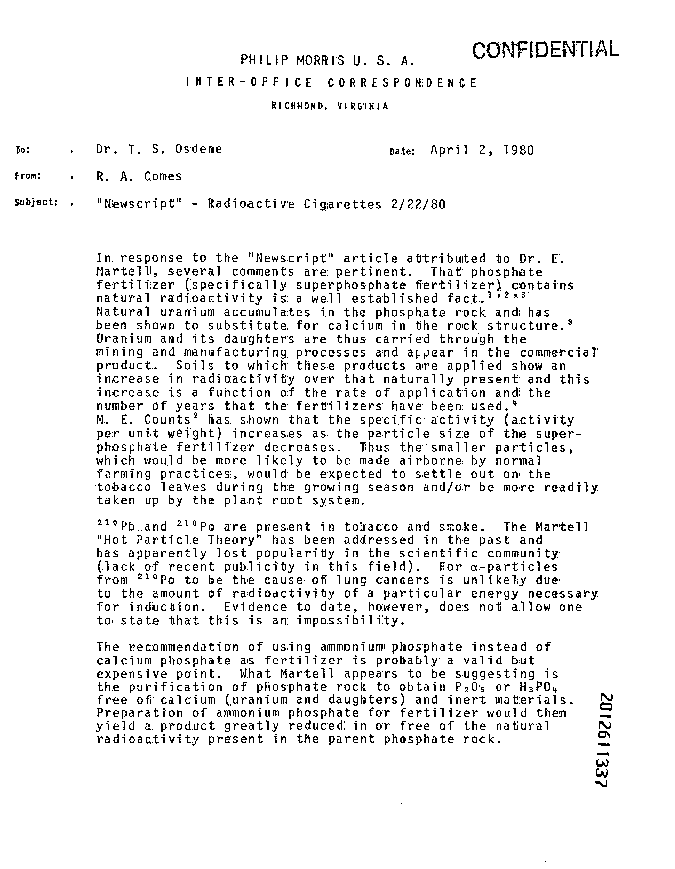
Big Tobacco knew radioactive particles in cigarettes posed cancer risk but kept quiet
TUESDAY, DECEMBER 12, 2006
At last! polonium 210 in cigarettes hits the news
This was apparently known to major tobacco companies as far back as 1974, and by 1980 a means to remove the radioactive content was also known – by using ammonium phosphate as a fertilizer, instead of calcium phosphate. This idea is rejected on the basis of expense. This is clearly revealed in the two publically available leaked ‘smoking gun’ memos (reproduced below from the www.tobaccofreedom.com website) from Philip Morris in 1980.
The key quotes are:
“210- Pb and 210 -Po are present in tobacco and smoke.”
…”For alpha particles from Po-210 to be the cause of lung cancers in unlikely due to the amount of radioactivity of a particular energy necessary of induction. Evidence to date, however, does not allow one to state this is an impossibility.”
“The recommendation of using ammonium phosphate instead of calcium phosphate is probably a valid but expensive point”


So what can we conclude from all this?
Well, obviously tobacco companies primary concern is not public health, they are motivated purely by profits. If there is a model for irresponsible corporations – they are it. No surprise there. They denied tobacco was linked to lung cancer despite overwhelming evidence for years.
More worryingly perhaps is that Government’s in the UK, the US and everywhere else have failed to act on this – either by commissioning the appropriate research or by banning the use of the offending fertilisers. Ultimately it is the governments responsibility to monitoir these issues. They have had 20 years since this has been in the public domain and done nothing. Only now when some unrelated Russian political murder brings this obscure substance into the public eye are we beginning to get a hint of a debate and the potential for change. Lets be under no illusions, this saga is a grotesque failing of our public health infrastructure and a total scandal and disgrace for all governments concerned.
On a broader front serious issues are raised about tobacco control generally and why it has historically been so lax. Things are now improving – with long overdue controls on advertising and smoking in public spaces – and the public health impacts of smoking beginning to fall from their post war high. This is the result of more effective public health education and better legal regulation – something that should obviously underpin effective policy on all drugs. Cigarette tobacco can still have up to 15% non tobacco content and there are 400 or so permitted additives, most of them pretty obnoxious looking (the list is available from the Tobacco Manufacturers Association). Tobacco products should have ingredients listings the same as any other product we put in our bodies:
THIS PRODUCT CONTAINS RADIOACTIVE POLONIUM AND LEAD
Similar lessons need to be applied to alcohol control, still far too unregulated, particularly regards marketing and packaging, contributing to the rapid current rise in alcohol related ill health. Why no health warnings on alcohol products? why no ingredients listings? why do we so rarely see alcohol content in units on alcohol products?
Organic tobacco is fairly widely available which apparently doesn’t use the offending fertilisers. Its not good for you but may be marginally less bad. Alternatively, you could go all Swedish and use ‘snus’ or ‘bandits’ – tobacco which you hold in you mouth rather than smoke. It can give you mouth cancer but is generally far less risky (they have half our level of smoked tobacco in Sweden and half the level of lung cancer).
It is incumbent on the Government to regulate dangerous drugs properly. This must include basic harm reduction measures such as making sure tobacco full of radioactive carcinogens isnt being consumed by millions of people on a daily basis.
LATEST: 12.12.06
In a rather depressing development, apparently a government TV ad that highlights the fact that cigarettes contain polonium-210 has been pulled because of…wait for it…sensitivities to the Litvinenko family. How totally ridiculous. Just as we are about to be told something that has been known for decades, they decide to pull the ad for the most absurd of reasons.
Surely the sensitivities of the tens of 1000s of who have lost relatives to lung cancer, or may do in the future, are more important. Im quite sure Litvinenko would not want this ad being pulled as part of his legacy, and nor would his family. The Litvinenko story is an opportunity to broadcast this story and achieve something positive, not squirrel it away.
The Polonium Brief: A Hidden History of Cancer, Radiation, and the Tobacco Industry
Brianna Rego*
*Department of History, Stanford University, Stanford, California 94305‐2024; [email protected].
The Polonium Brief
A Hidden History of Cancer, Radiation, and the
Tobacco Industry
By Brianna Rego*
ABSTRACT
The first scientific paper on polonium-210 in tobacco was published in 1964, and in the following decades there would be more research linking radioisotopes in cigarettes with lung cancer in smokers. While external scientists worked to determine whether polonium could be a cause of lung cancer, industry scientists silently pursued similar work with the goal of protecting business interests should the polonium problem ever become public. Despite forty years of research suggesting that polonium is a leading carcinogen in tobacco, the manufacturers have not made a definitive move to reduce the concentration of radioactive isotopes in cigarettes. The polonium story therefore presents yet another chapter in the long tradition of industry use of science and scientific authority in an effort to thwart disease prevention. The impressive extent to which tobacco manufacturers understood the hazards of polonium and the high executive level at which the problem and potential solutions were discussed within the industry are exposed here by means of internal documents made available through litigation.
The American public is exposed to far more radiation from the smoking of tobacco than they are from any other source.
—Reimert Thorolf Ravenholt (1982)
[Publishing our research] has the potential of waking a sleeping giant.
This subject is rumbling . . . and I doubt we should provide facts.
—Paul A. Eichorn of Philip Morris, cautioning against publishing internal
industry research on polonium (1978)
Am J Public Health. 2008 September; 98(9): 1643–1650.doi: 10.2105/AJPH.2007.130963PMCID: PMC2509609PMID: 18633078
Waking a Sleeping Giant: The Tobacco Industry’s Response to the Polonium-210 Issue
Monique E. Muggli, MPH, Jon O. Ebbert, MD, Channing Robertson, PhD, and Richard D. Hurt, MD
